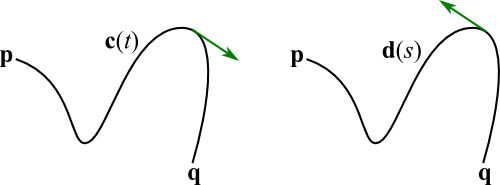Orienting curves
Given a curve $\dlc$ from the point $\vc{p}$ to point $\vc{q}$, we can parametrize $\dlc$ by a function $\dllp(t)$, for $a \le t \le b$. In this case, we know that $\dllp(a)= \vc{p}$ and $\dllp(b)= \vc{q}$. We could say that the curve is oriented from $\vc{p}$ to $\vc{q}$. At any point $\dllp(t)$ along the curve, you could tell its orientation by its unit tangent vector \begin{align*} \vc{T} = \frac{\dllp'(t)}{\|\dllp'(t)\|}. \end{align*}
We could also parametrize the curve backward, going from $\vc{q}$ to $\vc{p}$, by a function $\tadllp(s)$, for $a \le s \le b$, with $\tadllp(a)=\vc{q}$ and $\tadllp(b) = \vc{p}$. We could say that the curve parametrized by $\tadllp$ has the opposite orientation as the curve parametrized by $\dllp$. You could tell this by looking at the unit tangent vector at the point $\tadllp(s)$: \begin{align*} \vc{T} = \frac{\tadllp'(s)}{\|\tadllp'(s)\|}. \end{align*} For the same point on the curve, i.e., a $t_0$ and an $s_0$ where $\dllp(t_0)=\tadllp(s_0)$, the two unit tangent vectors would point in the opposite directions, as shown below.
We speak of orienting curves even without reference to a particular parametrization. Choosing an orientation of a curve is equivalent to choosing one of the two unit tangent vectors.
Thread navigation
Multivariable calculus
Math 2374
Notation systems
Similar pages
- Derivatives of parameterized curves
- Tangent lines to parametrized curves
- Parametrized curve and derivative as location and velocity
- An introduction to parametrized curves
- Tangent line to parametrized curve examples
- The arc length of a parametrized curve
- Parametrized curve arc length examples
- Introduction to a line integral of a scalar-valued function
- Line integrals are independent of parametrization
- Examples of scalar line integrals
- More similar pages
